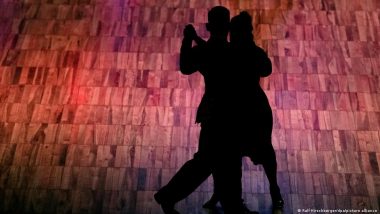Tango may be most closely associated with Argentina, but it also has a long tradition in Finland. Once a year, the town of Seinäjoki holds a popular festival that draws tango enthusiasts from all over.During the long summer nights in Finland, when the sun never completely sets, some 100,000 people travel to the Tangomarkkinat in Seinäjoki.
Also Read | Sports News | Krishna-Vishnu Win, Kashyap out of Canada Open.
The five-day festival in July transforms the streets of the town in southwestern Finland into a gigantic outdoor dance hall. Couples of all ages and skill levels sway to the sighing lament of the bandoneon in a paradise for tango enthusiasts.
Also Read | India News | NCP Chief Sharad Pawar Arrives at Yashwantrao Chavan Centre to Attend Party Meeting.
Tango is a national passion in Finland and has been for more than a century.
If award-winning Finnish filmmaker Aki Kaurismäki is to be believed, it wasn't the Argentinians who invented the tango, but Finnish farmers, who hoped it would scare off wolves. Only decades later, according to him, did Finnish sailors take the mournful music to South America.
'A sad thought that is danced'
Finnish tango fans like to advance this theory, but the truth is that the genre was in fact invented in Buenos Aires, in the port district La Boca. In the late 19th century, the neighborhood became a refuge for scores of immigrants seeking their fortune on the Rio de la Plata. They combined the instruments and folk music traditions of their former homelands, creating a new sound that was their gift to their new home.
One of the major figures of the genre, composer Enrique Santos Discepolo, once said, "Tango is a sad thought that is danced."
But tango is far more than just a dance: It sings of humanity's eternal defeat by life, the betrayal of the heart, loneliness and the longing for death. "Corazon, amor y sangre," or in English, "heart, love and blood" — that was the triad of the immigrant soul searching for a foothold in a strange new world.
The tango had a bad reputation
In the early days of the tango, the Argentinian elite was ashamed of the oh-so-obscene dance style from the gutter. Where immigrants were cheated of their dreams of prosperity, many took refuge in the criminal world, indulging in drunkenness, gambling and prostitution.
In 1904, police warned against the dance that, "with its indecent gestures promotes a contest of elements that always end up reaching for the knife."
It took a long time for the tango to become socially acceptable to the upper classes.
Kaiser Wilhelm II forbade his officers from dancing it, the Pope banned it, and in 1913, the Argentinian ambassador to Paris announced: "The tango in Buenos Aires is a dance that is reserved solely for houses of ill repute and bars of the worst kind. It is never danced in the salons of good society. To Argentine ears, the tango is associated with unpleasant notions."
Birth of the Finnish tango
But that warning came too late. Tangomania first reached Paris society, and from there, conquered the world. Legend has it that the tango was first danced before distinguished society in Finland by a Danish couple at the Hotel Börs in Helsinki.
The tango spread throughout the northern Arctic Circle in the 1920s and ‘30s, but the repertoires of dance orchestras focused especially on tangos from Germany featuring a "hammering" rhythm.
Back then, the tango was still the music of urban society, with people in the countryside remaining faithful to waltzes, Finnish jenkkas, and polkas.
The real birth of the Finnish tango came during the Second World War. While stationed at the front, composer Toivo Kärki wrote tangos like "Siks' oon mä suruinen" (That's why I'm sad) during breaks in the fighting, taking Russian romances and German marching music as a musical basis.
'The Finnish tango is only genuine in a minor key'
The tango remained popular after the war, as the melancholic sounds reflected the depression widespread among Finns — not least due to the months of darkness in the country. "We are only happy when we are unhappy," composer Mauri Antero Numminen once told Spiegel news magazine. That's why, he said, it's no wonder that the Finnish version is far more often in a minor key than a major one. "The Finnish tango is only genuine in a minor key."
Unlike Tango Argentino, the settings of the Finnish tango song lyrics are not found in disreputable bars, but in the countryside and nature. The tango "Satumaa" (Fairyland) by Unto Mononen, published in 1955, is about unattainable love.
That heartfelt song became Finland's secret national anthem.
Olavi Virta (1915-1972) is still considered the uncrowned tango king in the country; he's the equivalent of the Argentinians' favorite, Carlos Gardel — the embodiment of the fairy tale of the poor boy who became a celebrated global star.
The Beatles and tango competing in the pop charts
In the 1950s, dance floors were erected all over the country, and in every village the local sports club ran its own stage where popular tango and pop stars performed.
And although English-language songs increasingly conquered the charts in the 1960s, the tango could not be displaced. In 1963, for example, "All My Loving" by the Beatles and the tango "Tähdet meren yllä" (Stars over the sea), recorded by Reijo Taipale, were the best-selling songs in Finland.
Even after the 1960s, the Finnish tango never completely disappeared. The boom died down and there were fewer new compositions, but it lived on in dance halls.
The Tango Festival in Seinäjoki was first held in 1985 and has long been one of Finland's biggest festivals. There are composition and singing competitions, and countless candidates hope to be crowned tango king or queen. The big event is broadcast nationwide on television, and the winners become famous virtually overnight — at least in Finland.
This article was originally written in German.
(The above story first appeared on LatestLY on Jul 05, 2023 02:20 PM IST. For more news and updates on politics, world, sports, entertainment and lifestyle, log on to our website latestly.com).













 Quickly
Quickly

















